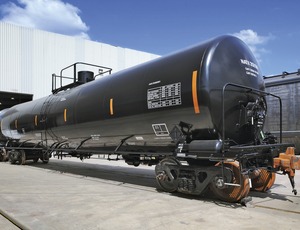
While the U.S. waits to see whether President Obama will approve the Keystone XL pipeline, more and more crude oil is moving by rail. After several fiery accidents in the past year, carriers are taking safety measures, hoping to garner public support for increased rail traffic from North American shale and tar-sands production centers. Most of the legacy fleet consists of old, dangerous DOT-111 tank cars that are overdue to be retrofitted or decommissioned.
Canadian Pacific (CP) and Canadian National (CN) railways recently announced a $325 surcharge on older DOT-111 cars laden with crude oil. Burlington Northern Sante Fe (BNSF) wants to take more control over crude-oil shipments by boosting its ownership of railcars. In February the U.S. carrier unveiled a $5- billion capital exenditure plan, including $1.6 billion for new rolling stock.
"It is a surprising move because BNSF spends 18% of its revenue on network elements of tracks, rights-of-way, ballast and so on," says Anthony Hatch, a New York City independent rail consultant. "This signals a giant shift back to car ownership by the railroads, and that is the exact opposite of the trend of the past 50 years."
It is unlikely, however, that railcar purchases will come at the expense of infrastructure improvements and continued work for construction firms. "Not when there's $5 billion at play," Hatch says, referring to BNSF's recent announcement of its 2014 capital spending program. "Rail infrastructure is in the best condition it's ever been in—I mean, ever. But … the wear and tear is enormous. It's a never-ending battle. "
Further, the Association of American Railroads (AAR) said freight railroads agreed with USDOT to eight voluntary safety measures to lessen the risks of moving crude by rail. Most significant for construction firms is the so-called "increased track-side safety technology," which AAR says will call for the installation of more wayside wheel-bearing detectors every 40 miles along tracks with trains carrying 20 or more crude-oil cars.
The move by CP and CN is to "force the issue" of safety, but the surcharge may not be enforceable because the DOT-111, while posing some dangers, remains within regulations. "It's honorable what they are trying to do, but the key is new regulations," Hatch says.
U.S. regulators issued, on Feb. 25, new rules for the testing of Bakken crude, following a series of explosive rail accidents involving crude oil in Quebec, Alabama and North Dakota. The USDOT says more than half the crude from the Bakken shale formation may have been misclassified, leading to its unsafe packaging and transportation. AAR says 3% of the current fleet lacks the safety measures to handle Bakken crude, which industry observers believe is more volatile than other crude products.
BNSF says the U.S. Pipeline and Hazardous Materials Safety Administration, USDOT, railroads and shippers now are engaged in hammering out new guidelines for tank cars.
Canadian Pacific does not want to wait. "CP believes upgraded tank cars are the best investments to enhance safety and is encouraging the shipping industry," says Ed Greenberg, CP spokesman.
Meanwhile, the new tank-car business is booming. Construction supply firm and tank-car builder Trinity Industries, Dallas, says it expects to deliver approximately 65,000 railcars in 2014.

Post a comment to this article
Report Abusive Comment